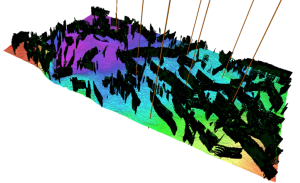用户推荐
Paradise software by Geophysical Insights AI-driven 3D Seismic Analysis
By James Ewell, Software Architect at Geophysical Insights
“Anyone who is involved in prospect evaluation and reservoir characterization should have no problem seeing evidence of the stratigraphic and reservoir facies details that a properly constructed multi-attribute classification can provide.”
- Dr. Bob Hardage, Former President, Society of Exploration Geophysicists.
The Paradise® AI workbench uses robust, unsupervised machine learning (ML) and supervised deep learning (DL) technologies in orchestrated workflows to accelerate interpretation and generate greater insights from seismic attributes, logs, and other geologic data. Leveraging Paradise, more information can be extracted from the data than is possible using traditional seismic interpretation systems, lowering the risk and cost of exploration and development.
User-guided workflows include:
- Attribute Generation, Selection, Color Blending
- ML-based Stratigraphic Analysis
- Interactive 2D Colormap
- 3D, DL-based Fault Detection, DL-based Seismic Facies Classification
- Geobody Generation
- Well Log Visualization and Well Log Cross plots
The interactive 2D Colormap unique to Paradise enables geoscientists to investigate ML-based Stratigraphic Analysis in 3D. Paradise also has a straightforward, drag-and-drop interface to Petrel and a scripting language with over 600 geoscience-specific commands. The product can be deployed either on-premises or in cloud environments.
Paradise uses Thermo Scientific Open Inventor Toolkit to provide industry-leading 3D rendering and a rapid application library to provide core surface, slice, and volume rendering capabilities for datasets far larger than VRAM or RAM. Multiple overlapping volume rendering displays are fundamental to the visualization in the Paradise machine learning results. Open Inventor helps us iterate and innovate within Paradise rapidly, and the support has been outstanding.
Geobodies from machine-learning (ML) stratigraphic analysis and the unique interactive Paradise 2D Colormap showing the neurons corresponding to the classes in the image. The wells are used to corroborate results and optimize the ML parameters. Image from onshore Colombia, courtesy of Lewis Energy.

Seismic fault surfaces (black) are generated through 3D deep learning (DL) technology with machine learning (ML) based stratigraphic analysis. Results are integrated in Paradise, and wells are included in the analysis to produce a comprehensive structural view of subsurface conditions.

RGB color blending and co-blending provide deeper insights between machine learning results and seismic attributes. Seismic faults with color bending are shown on the left, and a distinct channel feature is revealed by color blending on the right.


About Geophysical Insights
Geophysical Insights was founded in 2008 by Dr. Tom Smith with the vision of applying machine learning methods to seismic interpretation to reduce the risk of oil and gas exploration and the cost of field development. Shortly after launching the company, Dr. Smith assembled some of the best talent in the industry to develop the next generation of seismic interpretation software. The group’s mission was to apply machine learning to the problem of seismic interpretation and deliver the new capability in an off-the-shelf, commercial software product that any geoscientist could use. The new AI workbench, branded as Paradise®, would feature an intuitive, elegant interface that guides geoscientists in applying machine learning to many different types of geologic investigations. Over three years in development, including a year of field trials, Paradise was launched as a commercial product at the Society of Exploration Geophysicists (SEG) Annual Convention in 2013 and has since seen steady adoption worldwide, including by national oil companies (NOCs) and international oil companies.
Geophysical Insights continues to build capabilities in the Paradise AI workbench, which reveals more profound insights into the seismic response through machine learning and deep learning technologies. Made for large sets of data, Paradise is a ‘Big Data’ solution that easily scales from a single workstation to an enterprise. Using combinations of supervised and unsupervised machine learning algorithms enabled by GPU computing, seismic interpreters can extract more information from seismic and well data in Paradise than would otherwise be possible from traditional interpretation tools.
For more information, visit Geophysical Insights online at https://www.geoinsights.com/